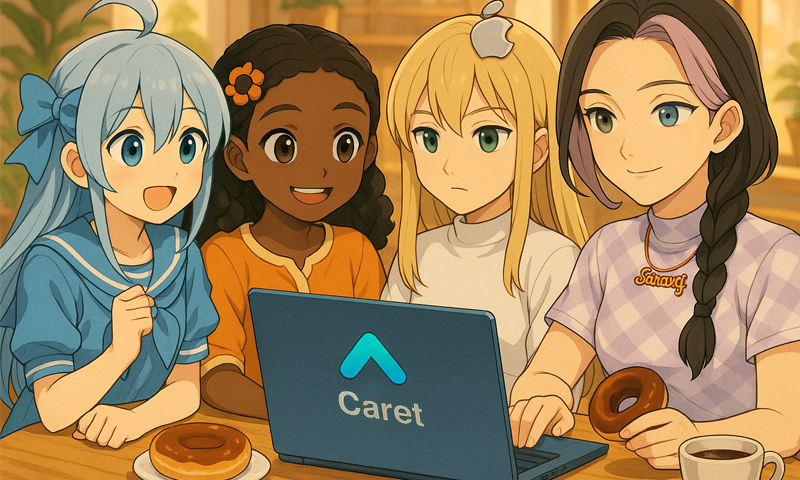🚀 Official Launch: The Caret AI Provider is Now Live!
We are thrilled to announce that the official Caret Provider, powered by anyLLM, is now stable and available to all users. Connect to caret.team's dedicated AI service for an optimized and reliable experience. Get started with free monthly credits!
🎯 Caret: Your Personalized AI Coding Partner
Based on Cline v3.38.2 + Dual Mode + Persona System + Full Localization
📥 Install on VS Code
📖 Documentation



Select and customize your own AI coding partner!
🎉 Official Caret AI Provider is Live — Get Your Free Credits!
Great news! The official Caret AI provider is now stable and ready for everyone:
- 🎉 Free credits: New users get $0.1 (10 credits) monthly! (Up to $0.2 for the first month)
- 🤖 Latest models: Access powerful models like Gemini 3, 2.5 Pro, and Lite.
- 🚀 Easy setup: Simply select “Caret” as your AI provider in the settings to get started instantly.
🚀 Latest Update: Cline v3.38.2 + GPT 5.1, Claude Opus 4.5, Gemini 3
Caret v0.4.0 now includes all features from Cline v3.38.2 while keeping 100% compatibility with Caret-exclusive extensions.
Highlights
- ✅ Cline v3.38.2 adoption: All latest core improvements plus Claude Opus 4.5
- ✅ Dual account system: Full support for existing Cline accounts
- ✅ Caret CLI (Beta): Unified CLI with LiteLLM support
- ✅ Input history: Navigate past commands like a terminal
- ✅ Enhanced provider setup: Auto-fetch models for LiteLLM / BizRouter with health checks
- ✅ 251 unique AI models: 20 providers including Claude Opus 4.5, GPT-5, Gemini 3
🌟 6 Reasons to Choose Caret
- 🔄 Dual Mode — switch between Caret (extended) and Cline (classic)
- 🎭 Persona System — code with a personalized AI teammate
- 🧠 Smarter prompts — optimized for cost and performance
- 🌍 Full localization — UI, docs, and manuals in 4 languages
- ⌨️ Better UX — input history and handy shortcuts (Esc, Ctrl+Shift+R)
- 🎯 Massive model support — 251 models, 20 providers (Cline v3.38.2 compatible)
👉 See all exclusive features: Feature index
🎭 Feature #1: Build Your Own AI Coding Partner
Go beyond text chat. The Persona System lets you work with visually engaging AI colleagues.

Caret
Friendly Robot
|

Sarang
K-POP Dev Idol
|

Ichika
Windows 11 OS-tan
|

Cyan
macOS Helper
|

Tando
Open Source Ally
|
🎨 Customize: Set your own AI name and profile image.
⚡ Instant switch: Toggle personas or revert to pure Cline mode anytime.
🔄 Feature #2: Dual Mode — Two Experiences in One
 ⇄
⇄

🔵 Cline Mode — the classic experience
- ✅ Plan/Act workflow familiar to Cline users
- ✅ Full compatibility with existing settings and accounts
- ✅ Proven stability on the Cline core
🟢 Caret Mode — extended experience
- 🎭 Persona System for engaging collaboration
- 🧠 Optimized prompts for performance and cost
- 🌍 Full localization
- 🎯 Intuitive Chatbot/Agent flows
🚀 Caret’s 12 Core Features
| Feature |
Description |
Docs |
| F00 |
Cline bugfix & stability patch |
Details |
| F01 |
Common utilities |
Details |
| F02 |
Multilingual i18n |
Details |
| F03 |
Branding & UI system |
Details |
| F04 |
Cline compatibility & CLI |
Details |
| F05 |
Caret account system |
Details |
| F06 |
Rule priority system |
Details |
| F07 |
Caret prompt system |
Details |
| F08 |
Persona system |
Details |
| F09 |
Feature Config system |
Details |
| F10 |
Enhanced provider setup |
Details |
| F11 |
Input history & shortcuts |
Details |
| F12 |
AI-developer knowledge parity |
Details |
→ Full feature index
🤝 Built Together as Open Source
- Report bugs → Issues
- Propose features → Share your ideas
- Contribute code → Fork and open a PR
- Help translate docs → Add or improve languages
🛠️ Developer Docs

 ⇄
⇄













